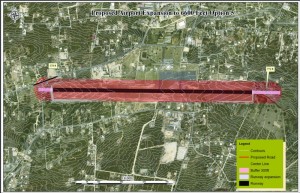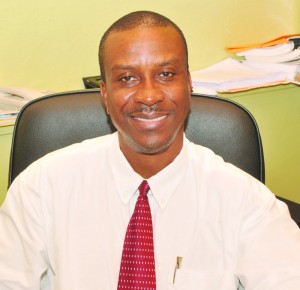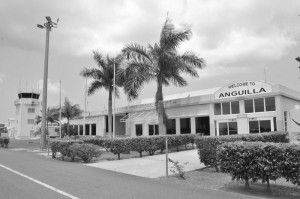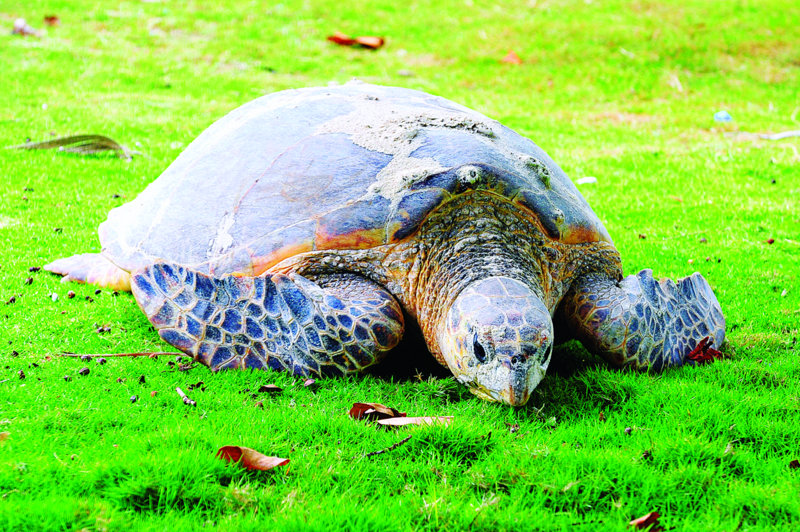
After taking up his appointment in March this year, as Chief Executive Officer of the Anguilla Air and Seaports Authority, St. Lucian-born Vincent Hippolyte has announced that a team of consultants is expected to visit Anguilla shortly. They will be holding discussions with Government and other stakeholders on a preliminary economic and financial analysis for the extension of the airport runway.
Mr. Hippolyte, whose office is located in the Terminal Building at the Clayton Lloyd International Airport, told The Anguillian in an interview on Tuesday this week that he was making arrangements for the consultants from CFAS, a United Kingdom-based company, to arrive in Anguilla in the middle of this month.

“One of the principal projects that we must undertake – because it is of particular importance to the economy ofAnguilla– is the extension of the runway,” he said. “This is good news because we need to advance the extension of the airport as the tourism economy inAnguilla, in part, depends on us having an adequate runway infrastructure to accommodate andattract traffic to support the island’s tourism industry.
“When the consultants are in Anguilla, they will be engaging a number of stakeholders including the Government, the Attorney General’s Chambers, tourism officials and others. This will be an initial visit. They mayhave to make another visitin order to ensure that the runway is properly assessed, and that they can develop the structure for what is called the ‘PPP – Private/ Public Participation approach’ to the development of the runway. This approach is being promoted very heavily not just inAnguilla, but everywhere else. This is because public projects can no longer be easily undertaken with public funds, so public/private participation is becoming a very viable route to realise a lot of things that are of particular good and interest to a country; and Anguilla is a case in point at this time.”

The CFAS consultants did some consultancy work for the Anguilla Government (over the past years) including the re-development of theBlowingPointPort, and have worked in otherCaribbeanislands. They have been involved in airport development inJamaicaandAruba.
Mr. Hyppolyte said the Anguilla Government was supportive of the visit of the consultants. “They will also be doing studies to determine the size and frequency of traffic that Anguilla would get from the eastern seaboard of theUnited States, such as source markets likeMiamiwith direct flights coming intoAnguilla. The consultants will also look at possibilities which would enableAnguillato be positioned to take advantage of opportunities that may come its way.”
The Anguilla Air and Seaports Authority’s CEO continued: “It is a lot of this preliminary work and crunching of numbers that will be done. The consultants will be looking at our tourism statistics, over the years, and doing an analysis of the figures to inform some of the things they will have to come up with. They will look at the financing of the project and how best to have the vehicle that would be responsible for financing it; the potential interest by investors who would want to invest money in undertaking the project; and to engage in discussions with them on this, and how they would be repaid for having made the initial capital outlay. It is that entire model that they will have to develop and all those inputs would advise the development of that model.
“When the consultants have spoken to the stakeholders, and have done their work, and are structuring the model, at the end of the day we want to realise something that is optimum forAnguilla. It will be important for us to realise it in a timeframe that would ensure that we will not lose too much of our tourism economy to another country. At least it is very important to me because of my responsibility for Air and Seaports. It is important that we do it within a quick timeframe to make sure that we can give a boost to our tourism economy, as well asposition ourselves to contribute more to the economy by taking advantage of opportunities.”
The present length of the airport runway is 5,400 feet. The proposed length is 6,600 feet with extensions at both ends. It is understood that the Government has already taken steps towards securing the required land.
In stressing the urgency of the development of the runway, Mr.Hippolyte said: “You cannot say that you are going to wait for the next two, three or four years to cross all the t’s and dot all the I’s before you start to do anything while your economy is dying. If you are not going to develop a new airport somewhere else, then what you have you must work with. But the terminal, apron infrastructure and the tower must be attended to. All of those must be part of a master plan.
“We will have to determine, eventually, whether it would be necessary for us to have more than 6,600 feet in the future – such as by the year 2020 or 2030 – that we should have 7,000, 8,000 or 9,000 feet. We must decide that. Once we do so, it would be necessary to consider at what point we would be able to do the terminal building… and you have to begin to phase things in. We are saying that while developing the master plan, we are ensuring that our tourism economy is sustainable and working, andthat we take advantage of opportunities that are going to generate money for us.”
Mr. Hippolyte is also looking forward to the future development ofAnguilla’s seaports. “We speak a lot about the airport, but the seaports are other areas that need a lot of attention because we must also position ourselves to take advantage of opportunities,” he pointed out.
In the meantime, since his arrival inAnguillain March, he has undertaken to further develop the Air and Seaports Authority. “The structure of the organisation has been developed in terms of what is needed for the regulatory requirements,” he added. “This has been proposed to the Board and submitted to the Minister [the Hon. Evan Gumbs] as well so that he is aware of what is required.”
Mr. Hippolyte has wide experience in the field of maritime and aviation business. He started as an Economist and later became involved in management. Among other things, he developed the first model of a subsidiary company of the St. Lucia Air and Seaports Authority which he eventually managed. He then served as CEO of the parent company. He was Chairman of the St. Lucia Free Zone Authority; a Director of the St. Lucia Tourist Board; Chairman of the St. Lucia Cruise Tourism Committee; Director of Anchorage Investments Ltd inSt. Lucia; a Director of the St. Lucia Marine Terminals Ltd and sat on a number of other committees.
In 2007, he undertook consultancy work in the maritime and aviation field in the widerCaribbean. He was the first Chairman of the Eastern Caribbean Civil Aviation Authority (then the Directorate of Civil Aviation). He sat as a Director of the OAS Board with responsibility for ports in the hemisphere, and assisted in developing the Dominica Seaports Authority which was merged with the Department of Civil Aviation at the recommendation of the IMF. He was a consultant for the Port Authority Corporate structure in St. Vincent; and later reviewed the tariff for that facility and, with the assistance of another consultant, he developed a model for an Authority for Roads andPublicBuildingsalso inSt. Vincent. He advised on the tariff for theSt.Kitts Air and Seaports Authority. He was a lecturer at the University of the West Indies; and for some time worked as a consultant for the British Government to develop a strategy for access to Montserrat, from where he came toAnguilla.
Mr. Hippolyte said he was anxious to serve inAnguillaon a two-year contract to help the island with the development of its Air and Seaports Authority – a new initiative it has embarked on. However, he made this comment: “If I am not enabled to perform the responsibilities of the position and advance the Anguilla Air and Seaports Authority, I will unfortunately relinquish the positiion.”








